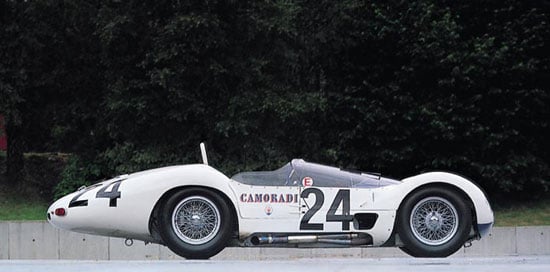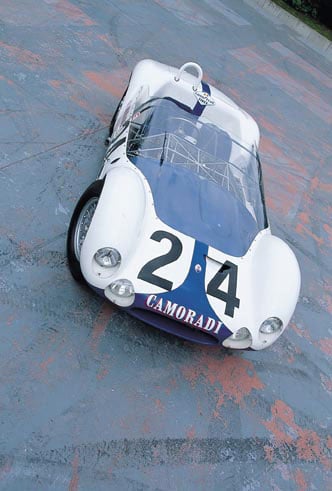
The following is an extract from Andy Heywood’s feature in Auto Italia magazine, January 2004

At the time of its birth no one could have predicted that the Birdcage would ever compete internationally – never mind at Le Mans. Maserati conceived the Tipo 60 as a contender for domestic events, and intended to sell the car to wealthy privateers. The prototype, chassis number 2451, is particularly relevant to the story of the Streamliner, as they are one and the same car. How this came about involves the usual Maserati chaos, coupled with the advances of a smooth-talking American.
The first order was taken from California, but in order to be competitive in the most important sports racing class in the US, the Americans petitioned that the car’s two-litre engine needed to be upped to three litres. Development of the engine to 2,890cc produced 250 reliable horsepower and the six chassis that were ordered during 1959 were switched from being Tipo 60 to the larger-engined, but otherwise identical version, known as Tipo 61.
 Maserati enlisted Stirling Moss to drive the prototype at its debut, in July 1959, and Moss won the event easily. Interest in the new car in either form was now growing, and by the autumn it had come to the attention of a man with great intentions. Lucky Casner and his Camoradi team were to become champions of the Birdcage and one of Maserati’s best customers, but when he arrived in Modena that September it seemed that they had nothing to sell him. Casner tested the prototype at the Modena Autodrome and immediately saw its potential. He met with Omer Orsi, managing director of Maserati, with a view to securing two Tipo 61s to campaign in the 1960 World Sportscar Championship. Trouble was, all the Tipo 61s destined for construction in 1959 had already been sold, as well as many of the cars due in 1960. Casner particularly wanted to run the new car at the Nassau Trophy race in December, and so the only option was for Maserati to transform the one ‘spare’ car, the prototype, into a Tipo 61. Hastily, that first Tipo 60 was modified to three-litre specification and despatched to Casner in Miami.
Maserati enlisted Stirling Moss to drive the prototype at its debut, in July 1959, and Moss won the event easily. Interest in the new car in either form was now growing, and by the autumn it had come to the attention of a man with great intentions. Lucky Casner and his Camoradi team were to become champions of the Birdcage and one of Maserati’s best customers, but when he arrived in Modena that September it seemed that they had nothing to sell him. Casner tested the prototype at the Modena Autodrome and immediately saw its potential. He met with Omer Orsi, managing director of Maserati, with a view to securing two Tipo 61s to campaign in the 1960 World Sportscar Championship. Trouble was, all the Tipo 61s destined for construction in 1959 had already been sold, as well as many of the cars due in 1960. Casner particularly wanted to run the new car at the Nassau Trophy race in December, and so the only option was for Maserati to transform the one ‘spare’ car, the prototype, into a Tipo 61. Hastily, that first Tipo 60 was modified to three-litre specification and despatched to Casner in Miami.
A failure of the rear suspension De Dion tube at Nassau, while Carroll Shelby was at the wheel, was put down to teething troubles. For the first race of 1960 in Argentina, Casner put Masten Gregory in the repaired car but again it broke – this time the crownwheel and pinion. Chassis 2451 then missed the next significant race in Cuba, but Gregory and Shelby were back in it for the Sebring 12 Hours. Again there was bad news. This time an oil pipe split and the dry engine destroyed itself. Repaired once more, the next scheduled outing would be the Targa Florio. Maserati put Casner under a little pressure to use Italian drivers and Targa Florio experts for this event and so, on May 8th, Umberto Maglioli started the race in 2451. By lap five he was in the lead and, when he came in a lap later, he handed over to Nino Vaccarella. Vaccarella drove like the wind, chalking up a five-minute lead over the next-placed Porsche of Bonnier and Hermann, but disaster was just around the corner. Unknown to Vaccarella, a stone had punctured his fuel tank and while committing himself for a particular corner, the engine died, causing the car to veer into a ditch. Nino survived to become a Targa master, but the Birdcage body was looking distinctly second-hand. While the Camoradi circus moved on to the Nurburgring, 2451 again returned broken to Maserati.
 |
 |
Casner fielded three Camoradi Tipo 61s at Le Mans in 1960, but struggled to find enough drivers. Moss had upped his fees after again winning for Camoradi at the Nurburgring, and Lucky just couldn’t afford him. Both Gurney and Shelby were approached but, in the end, his top drivers for the Streamliner would be Masten Gregory and Chuck Daigh. The latter’s technical experience prompted those prophetic words at the start of this feature.
Guerrino Bertocchi was acting chief mechanic for Le Mans and he told the drivers that the engine was good for a constant 6,500rpm. Daigh argued quietly but respected Bertocchi. Gregory, who always pushed the machinery anyway, did what Bertocchi told him and it was he who started the race.
After a slow start, Gregory moved into first place at the end of Mulsanne and pulled out a lead over the Ferrari of Frere/Gendebien. By the time he stopped after two hours, the lead was over four minutes. The Streamliner had clocked a record 169mph on the Mulsanne Straight. The car was fuelled up, Daigh was pumped up, but when he came to leave the pit, the starter motor would not engage, and repairs by Bertocchi took over half an hour. By the time Daigh finally got away, he was in last place.
 |
 |
Maserati collector Hartmut Ibing, became the owner of this car – the fastest of all the front-engined Birdcages, and still highly original – in 2000. Following a restoration by Steve Hart in the UK, the car debuted fittingly at the 2002 Le Mans Classic. If one car demonstrates the highs and lows of the Birdcage more than any other, it is surely the Streamliner. None was more unreliable, but then again, none was faster.
Words courtesy of Andy Heywood and Auto Italia magazine.
See www.auto-italia.co.uk or call 01858 438817 for back issues and subscriptions.
Pictures courtesy of Phil Ward and Auto Italia.


